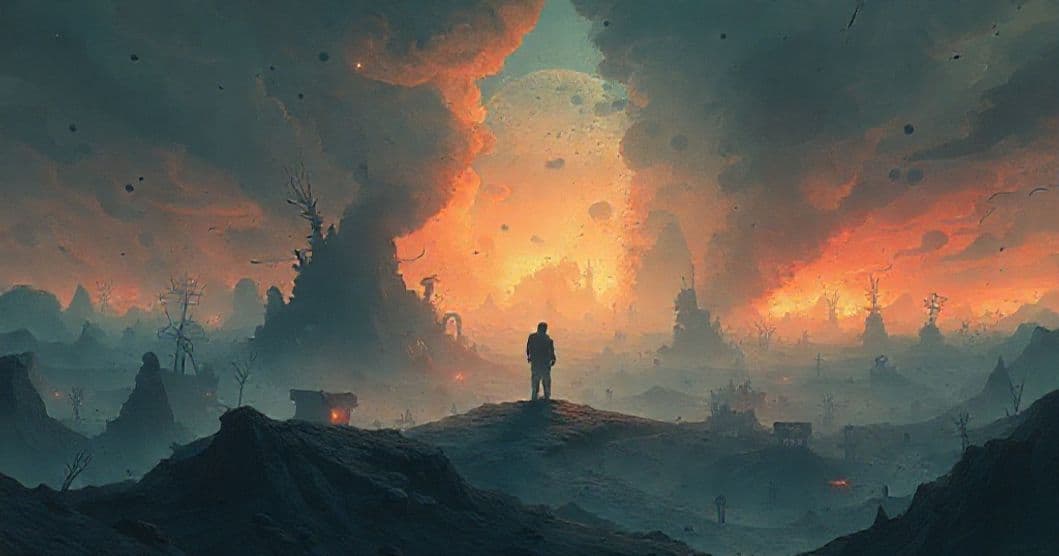Part 1: Dream Presentation
Dreams have a way of infiltrating our consciousness with visceral intensity, and this recurring apocalyptic vision reveals much about the dreamer’s emotional state. Here is the dream narrative as experienced:
I’ve grown to dread sleep, for it no longer offers rest but a relentless cycle of chaos. My dreams have become a labyrinth of apocalyptic visions, each iteration a variation on themes of destruction and uncertainty. What once felt like a peaceful escape now leaves me frayed, my mornings marked by lingering anxiety and a quiet irritability that persists for hours after waking. The scenarios are never identical yet share a core of dread: natural disasters, foreign landscapes, and endless, aimless movement. Flooding is the constant thread—a recurring motif that drowns both my waking and sleeping consciousness. Whether I’m wandering through familiar trails, camping grounds, or strange beachside towns, water rises around me, swallowing paths and leaving only the skeletal remains of what once existed. These places shift between memories and strangers: a coastal highway I’ve never seen, a Greek-Italian hybrid town where streets twist into waterways, or a rural road I might have driven once, now lined with bare trees and farmland turned to mud. Driving is a common nightmare: I’m alone in a car, headlights cutting through darkness, rural roads stretching endlessly into the distance. Tornadoes touch down ahead, hurricanes roar overhead, and asteroids streak across the sky, yet I keep driving—compelled forward despite the chaos. Sometimes I abandon the car, walking into desolate forests where trees stand leafless, or into campsites where tents lie half-submerged. Every journey ends at a dead end: an overpass where the world is underwater, or a beach where the tide has risen to my chest, forcing me back. The seaside town remains the most disorienting: architecture blends Mediterranean styles with unfamiliar structures, streets crowded with strangers speaking languages I don’t understand. I’m drawn to the ocean, yet as I walk toward it, the water creeps up through narrow alleys, trapping me in a maze of rising floodwaters. There’s no resolution, no escape—only the abrupt end of consciousness, leaving me gasping awake, heart pounding, with no sense of closure. This cycle repeats, and I’m left wondering if these dreams are trying to tell me something about the chaos I feel in my waking life.
Part 2: Clinical Analysis
Symbolic Landscape: Unpacking the Dream’s Visual Language
Want a More Personalized Interpretation?
Get your own AI-powered dream analysis tailored specifically to your dream
🔮Try Dream Analysis FreeThe recurring elements of this dream form a rich symbolic landscape that mirrors the dreamer’s internal emotional terrain. Flooding, a dominant motif, represents emotional overwhelm and the feeling of being swept away by forces beyond control. In dream psychology, water often symbolizes the unconscious mind—rising water can signify repressed emotions breaking through awareness. The dreamer’s experience of walking through or driving through flooding suggests a struggle to navigate these emotional currents while remaining in motion. The inability to stop or change direction (driving endlessly, walking into dead ends) hints at a sense of being trapped or stuck in life’s circumstances.
The seaside town introduces a layer of the unknown: unfamiliar architecture, languages, and people. This can symbolize identity exploration or anxiety about transitions (moving to a new place, changing roles). The blending of Mediterranean architectural styles with the dreamer’s native country might represent a search for meaning or belonging in a fragmented world. The town’s flooding, despite the dreamer’s attempts to return to safety, suggests that even in spaces that should feel familiar or comforting, chaos persists—a metaphor for unresolved internal conflicts.
Psychological Perspectives: Interpreting Through Theoretical Lenses
From a Freudian perspective, these dreams may reflect repressed anxieties about control, loss, or existential threats. The repetition of natural disasters could symbolize overwhelming forces in the dreamer’s life—perhaps work stress, relationship challenges, or fear of change that remain unprocessed. The driving alone on desolate roads at night aligns with Freud’s concept of the id (the unconscious drive) acting out in dreams, with the dreamer’s compulsion to keep driving despite danger representing an attempt to control or suppress these anxieties.
Jungian analysis frames the dream as a reflection of the collective unconscious and personal growth. The recurring apocalyptic themes might represent the shadow self—parts of the psyche the dreamer avoids or fears. The dead ends and flooding could symbolize the need to confront these shadow aspects rather than escape them. The seaside town, as a foreign yet alluring place, may represent the dreamer’s anima/animus—the feminine/masculine aspects of self that need integration. The inability to recognize people or places might indicate a disconnect between the conscious self and these deeper aspects.
Cognitive psychology offers another lens: dreams as a form of threat simulation. The brain processes stress and uncertainty during sleep, and these apocalyptic dreams may be the mind’s way of rehearsing responses to potential threats. The dreamer’s persistent driving despite danger could reflect an overactive threat-detection system, or a need to feel in control of overwhelming situations.
Emotional & Life Context: Connecting Dreams to Waking Reality
The dream’s intensity suggests the dreamer is navigating significant life changes or unresolved emotional stressors. The transition from enjoying sleep to dreading it indicates that dreams have shifted from restorative to emotionally draining—a sign of psychological distress. The recurring natural disasters may mirror real-world anxieties about climate change, financial instability, or personal uncertainty (e.g., career changes, relationship shifts).
The isolation in driving alone and the lack of familiar faces in the seaside town hints at feelings of disconnection. The dreamer may be experiencing loneliness or a sense of not belonging in their current environment. The
